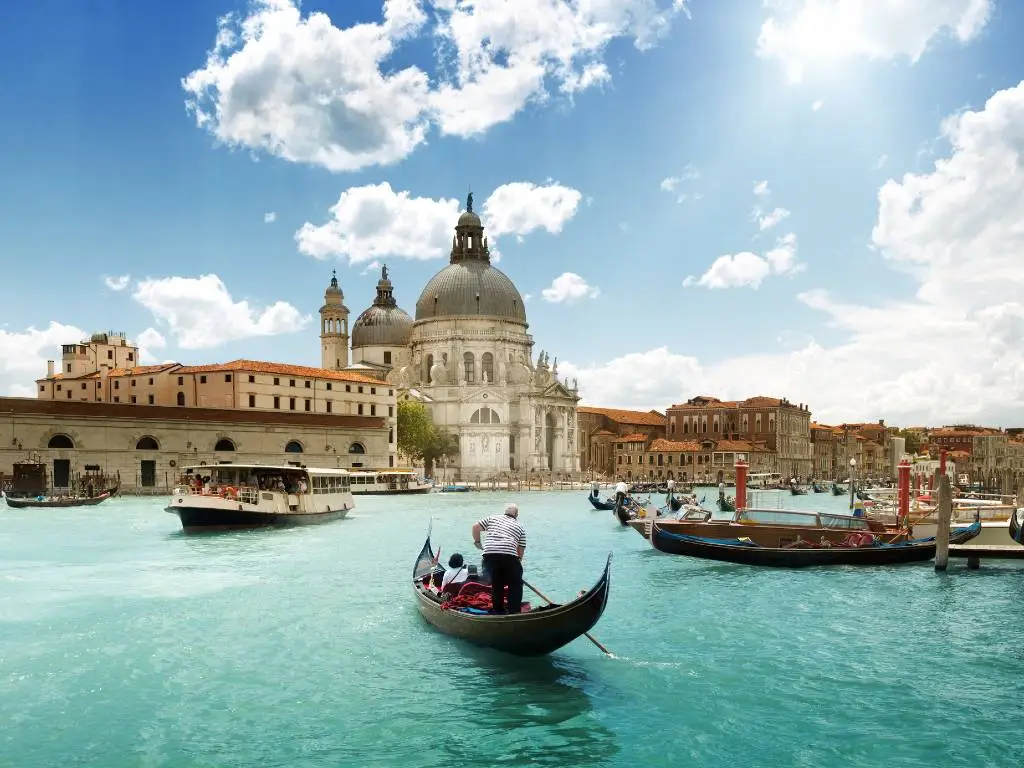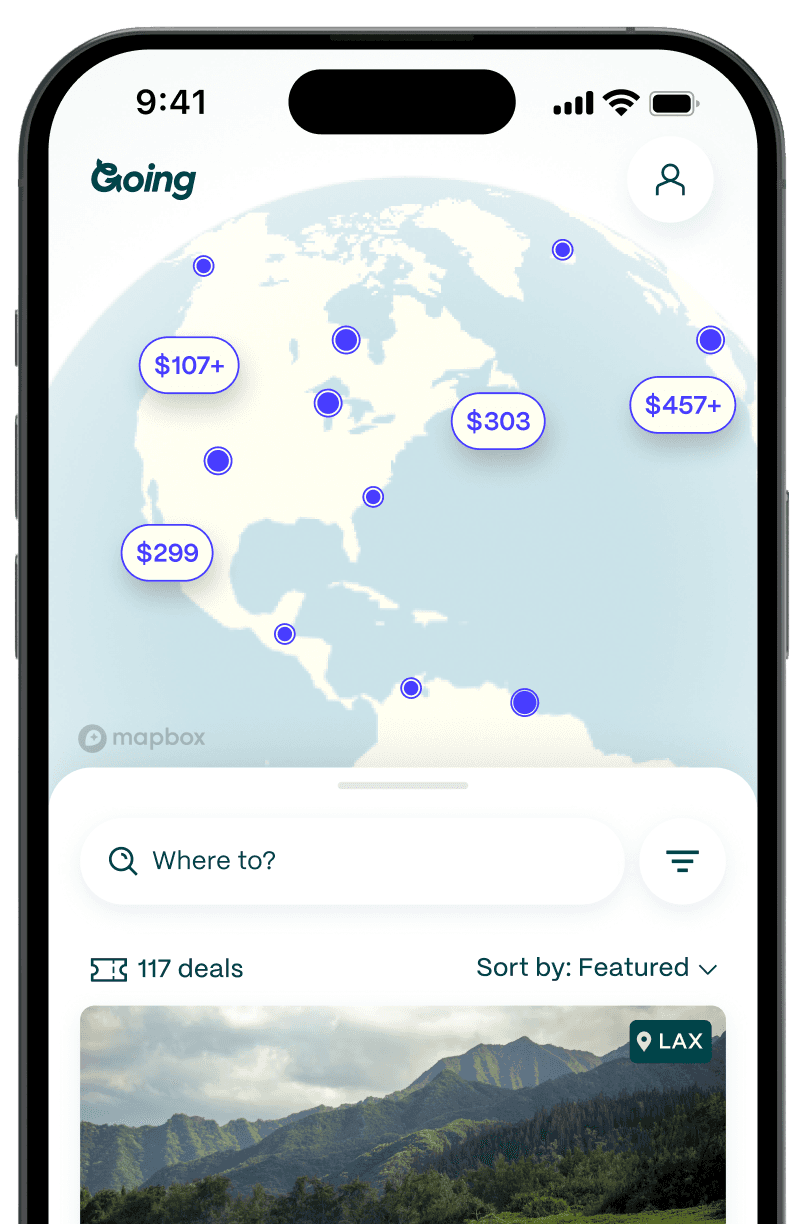
Europe Travel Tips: How to Make the Most of Your Trip in 2026!
Table of Contents
Whether you're a first-time traveler to Europe or a frequent visitor, a foreign place is always a little foreign if you don’t live there. With that in mind, we’ve compiled a list of some tips for traveling in Europe that will help anyone have a better trip—whether it’s your first visit or your hundredth.
>> Planning a trip to Europe? Join Going and get amazing deals like $262 roundtrip nonstop to Paris or $533 to the Greek Islands.
1. Don't try to do too much.
Every traveler is different, of course. While some might just want a taster platter of Europe and prefer to travel quickly to several cities, others may prefer lingering longer in just a few places. But this advice applies regardless of your travel style. Whatever you plan to do—whether it’s cramming your itinerary full or taking a slightly more leisurely trip—take your itinerary and categorize every sight or activity as a “must do” and “if there’s time.” Adjusting your expectations about how much you can accomplish will help ensure you don’t end up cranky and unable to appreciate the trip—or running yourself ragged to check off every possible travel box and making yourself sick.

2. Consider open-jaw flights to save time.
Standard roundtrip tickets mean you’ll need to circle back to your arrival airport to fly home, which could mean a wasted travel day. Instead, look at your options for open-jaw flights—flying into one city and home from another. They’re often comparable price-wise with simple roundtrip tickets, and sometimes even cheaper.
3. Consider the merits of traveling in the off season or shoulder season.
Not only is peak season travel almost always more expensive, popular places are far more crowded in the high season. Traveling in the off season or shoulder season means you’re likely to save money and avoid the longest lines at major attractions. The trade-off is bringing a sweater or an umbrella, but for many travelers, the cooler weather is a great trade-off for fewer crowds.
4. Use Rome2Rio to compare transportation options.
Europe is criss-crossed with train lines, and that used to be the best way to get around the continent. Sometimes, it still is—but not always. We love Rome2Rio for showing us every option for getting around, from driving to flying, with prices and transportation times so we can decide which option makes the most sense for our trip.
5. Focus on getting across the ocean as cheaply as possible, then use budget airlines or ground transportation to get to your final destination.
You may have seen us mention the “Greek Islands trick” a few times. This is basically what it boils down to: if flying directly to the place you really want to go is expensive, look for the cheapest flight to any major hub in Europe. Then, look for flights on budget carriers to your final destination (or see if getting there by train, ferry, bus, or car is more efficient). The latter option requires more logistical planning on your part, but it may save you quite a bit of money.
>> Check out our layover guides for details on short stays and connections across Europe.
6. Learn a bit of the local language.
No one expects you to be fluent for every vacation you take, but it’s only polite to learn some key phrases in the local tongue—think phrases of politeness (please, thank you, excuse me) and things you might say often as a traveler (how much is this, I would like to order, may I have the check). You’re a guest in someone else’s country, so even though they may switch to English soon after you start a conversation, residents typically appreciate the effort.
7. Don't overpack.
Although many airlines tend to allow one free checked bag on overseas flights, resist the temptation to bring a lot of “just in case” items. If you’re taking the train, you’re responsible for hauling your bags on and off every car and (possibly) into luggage racks above the seats. And if you’re taking low-cost airlines, there’s often a fee and a strict size and weight limit for checked—and sometimes carry-on—bags. Pack light, and remember you can buy stuff you run out of (like toothpaste) wherever you go.

8. Eat like the locals eat.
This isn’t just about eating what’s local and in season (though that’s always a good idea). Taking food cues from the locals may mean getting picnic supplies from the weekly market because it’s fresh and cheaper than a restaurant meal. It may mean choosing that little cafe where all the taxi drivers or gondoliers are eating. It may mean eating your biggest meal at lunch and then joining the locals for a few small tapas plates or aperitivo nibbles instead of a big dinner.
It always means avoiding the “tourist menu,” printed in multiple languages and/or displaying pictures of dishes, since these tend to be overpriced and cannot be relied upon for quality. It’s important to note, however, that smoking remains far more prevalent throughout Europe than it now is in the United States—including in some restaurants. The atmospheric sidewalk tables are often full of smokers, so keep that in mind when choosing a table.
9. Avoid ATM and credit card fees.
There are a couple fees you’ll run into when using your bank card at ATMs in Europe—there’s the fee for using a bank that’s not yours, and there’s a foreign transaction fee. Not every bank adds both, so check with your bank before you travel. Even if your bank doesn’t charge either of these fees, the bank where you’re withdrawing money in Europe probably will. You’ll pay fewer fees if you withdraw larger sums of money less often during a trip, rather than withdrawing only what you need every couple of days. You’re also apt to pay lower fees if you use an ATM at an actual bank rather than one from a company like Travelex or Euronet. If you have a Charles Schwab debit card, the bank will reimburse you for any foreign ATM fees.
Additionally, check to see what kind of fees your credit card might charge. Some cards charge up to 3% while others, such as the Capital One Venture Rewards Card, and Chase Sapphire Preferred Card don’t charge any fees.
10. Wear comfortable walking shoes.
Unless you walk for a good portion of every day in your everyday life, you’re unlikely to be prepared for all the walking you’ll do when you’re on vacation. Few things will ruin a trip quicker than aching feet, so trust us when we say comfortable shoes are your best friends—especially on the uneven cobblestone so prevalent in Europe.
11. Dress like a local.
While the days when tennis shoes marked you as American are gone (many Europeans wear stylish sneakers daily), looking like you’re an outsider is still a pretty good way of becoming a target for pickpockets and petty thieves. You can make yourself a little less conspicuous by adopting some of the local fashions—for instance, swap the baseball cap and flip flops for a slightly more dressed-up casual look.

12. Familiarize yourself with common travel scams.
In just about every major city in the world, there are opportunists who’ll try to part you from your money—and while Europe is generally quite safe, there are a few recurring ways people use to try to do just that. There’s no need to be paranoid, but it’s wise to do a quick web search for common travel scams in the cities you plan to visit so that you don’t fall prey to a known hustle.
13. Know your mobile phone’s international plan before you leave home.
It’s so hard to imagine getting through the day without the use of our mobile devices, and that feels especially true when traveling. We want to post photos to Instagram, navigate unfamiliar cities, and look up restaurant recommendations. But before you leave home, check in with your mobile provider to find out your international usage options—and how much it will cost to make or receive calls, send or receive texts, and use data.
Each provider and plan is different, so make sure you get in touch with your provider to see what your plan options are specifically. If it’s expensive, your best option is to keep it in airplane mode with the WiFi turned on so you can connect to WiFi when it’s free but keep your overall bill low. If you have an unlocked phone, you can also look at buying a local SIM card when you arrive.
14. Alert your bank and credit card companies that you’ll be traveling.
Banks can be quick to freeze a card when it looks like there’s suspicious activity. And if your card suddenly switches from daily use in Poughkeepsie to daily use in Paris, that sure seems suspicious without context. Make sure you set travel alerts on every card you might use when you’re traveling, telling the bank(s) when and where you’re going.
15. Download useful travel apps.
While you may not want to use your mobile phone or tablet much away from WiFi (depending on your international plan), there are plenty of super useful apps for traveling in Europe. From translation to transportation booking to conversion to guided city and museum tours, there’s an app for just about everything.
16. Have a jet lag game plan.
Jet lag is no joke, and while some amount of discombobulation is to be expected when you zip your body across several time zones in a few hours, you can combat the worst effects of jet lag.
Make sure you’re well-rested and hydrated before you leave home. Skip the caffeine and alcohol on your flight day in favor of lots and lots of water. And when you land, don’t nap—stay awake until the sun sets, getting outside and walking as much as possible.
17. Know the opening hours of the things you want to see.
You might have a Spain trip all planned, with flights and hotels booked, only to find out the Reina Sofia Museum is closed on Tuesdays, the only day you’re in Madrid.
Make sure you look at the open days and times of the sights you’d be disappointed to miss before you solidify all your travel plans. Learn about whether shops and restaurants close during the middle of the day, too, which can impact how you structure your sightseeing.
18. Don’t discount the perks of a vacation apartment instead of a hotel.
Families and small groups traveling together routinely hear that getting a vacation rental instead of a hotel room is a good idea, but vacation rentals can be an excellent option for any traveler—even if you’re only staying a couple nights. Vacation rentals are often more comfortable, offering space to relax besides just sitting on the edge of the bed, and of course having use of a kitchen means you can make your own coffee or refrigerate your picnic supplies. Not only that, depending on the location, an apartment may be cheaper than many of the area hotels.

19. Get tickets to museums and attractions in advance.
At Europe’s most popular attractions, there is often a long line at the ticket office—or a limited number of tickets per day that sell out well in advance. Learn what museums and other attractions on your itinerary fall into those categories so you can buy tickets before you leave home when possible.
20. Keep your big-ticket item receipts to claim your VAT refund.
Shopping in Europe means paying taxes on what you buy. If you don’t live in the EU, however, you can get some of those taxes refunded on your way home. The Value-Added Tax (VAT) changes depending on what country you’re in, from 8% to 27% as of this writing, and the minimum amount when a potential VAT refund kicks in varies by country, too.
If you spend enough at a shop, you should receive a form to fill out in addition to your receipt (you may be asked to prove you’re not local—a passport will do). Bring all of these, the VAT refund forms and the accompanying receipts, to the airport and present them to the customs office for review and to get the documents stamped. You may be able to turn in the stamped forms at the airport before you fly, or you may need to mail them from home. (Note that refunds can take months, and sometimes they don’t come at all. But if you’re a big spender, it’s definitely worth a try.)
21. Learn the local tipping customs.
When you’re an American accustomed to tipping 20% or more for everything from a beer to a taxi ride to a haircut to a fancy meal, it might be so ingrained that it’s hard to not tip. But, depending on where you go in Europe, tipping may not be the norm—and in some places, people will actively try to give you your tip back.
In restaurants, a “service fee” or “cover charge” may be included in every bill, which means the tip is built in. Taxi drivers often appreciate exact change, or maybe an extra euro if they’ve been especially helpful with luggage. If you pay for a meal with a credit card, you’ll notice there’s rarely a line for adding a tip. This means if you want to leave a few euro, you’ll need to have cash on hand. Do some research into the tipping rules in the places you’re visiting. One exception to the usual tipping customs in Europe is if you take a guided tour—giving your guide a tip of a few euro per person is a good idea.
22. Don’t assume the waiter forgot about you after dinner.
Generally speaking, once a party has been seated in a European restaurant, the table is theirs for as long as they want it. Waiters aren’t looking to turn that table over three times in a night, their goal is to give every diner the chance for a leisurely meal without constant interruptions.
In other words, when you’re done, the waiter won’t come over to ask if you want the check—you’ll probably need to flag them down to get it. This isn’t a snub or a slight. Instead, it’s a sign that they respect your right to hang out at that table with your friends or family until you’re ready to leave.
23. Bring the right electrical converters and adapters.
Find out what specific plug adapters and electricity converters you need to make sure you don’t fry your gadgets. If you’re traveling to more than one country, a universal converter and adapter kit may be a good idea.
24. Public toilets aren’t always free.
Sometimes it’s a challenge to find a public toilet in Europe. Restaurants have them, of course, but they’re rarely indicated by big signs (probably to keep non-customers from using them). Museums and train stations have bathrooms, too, but once you’ve found the loo you might run into an unexpected barrier—you have to pay to use it. Sometimes there’s a coin-operated turnstile to get in, and sometimes there’s a bathroom attendant whose job it is to keep the facilities clean and well-stocked.
Note that in unmonitored toilets, stalls are often lacking in basics like toilet paper. Carry a packet of tissues with you just in case. And whether or not you’re a customer, McDonald’s and Starbucks tend to be good places to stop for an emergency bathroom break if you need one.

25. Know when a rental car is your best transportation method.
Renting a car for your European trip might sound like it would be too expensive—not to mention that it might seem daunting to drive in a country where you don’t speak the language. However, if you’re traveling with a few people who can all contribute to the cost of the car and fuel (which is more expensive in Europe), it might be more cost effective to drive rather than take the train.
Not only that, there are some destinations, such as Bavaria or Tuscany, that don’t have extensive train or bus service. In order to visit, you’ll need to drive. Do some research on driving in the countries you’ll be visiting before you go to find out whether you need to get an international driving permit (offered at your local AAA for $20) and what safety gear you must have in the car at all times (the rental company needs to provide it).
>> Get tips for finding the cheapest rental car.
26. Don’t feel guilty if you need a dose of home during your trip.
For better or worse, companies like McDonald’s and Starbucks are everywhere these days. And while we might want to explore the local cuisine as much as possible, it’s not unusual to pine for a little taste of home now and then. Don’t beat yourself up about it. (In fact, you can learn something about local culture even at McDonald’s, where each country has a unique offering or two on the menu.)
27. Take guided tours that are tailored to your group’s interests.
When everyone in your group wants to see a museum or attraction, it makes sense to book a guided tour. Go beyond the one-size-fits-all tours, though, to make sure everyone in your group enjoys it. Traveling with kids? Find a guide that specializes in bringing history to life for youngsters. Bunch of history buffs? Make sure your guide will spend more time on historic details. Art lovers? Tour with an art specialist to get more information than just the basics. There are tours for just about every area of interest, and you’ll get much more out of the experience if you find the ideal one for your group.
28. Choose as centrally-located a hotel as your budget allows.
After your airline ticket, accommodation is often the next-biggest vacation expenditure. You might be tempted to book a room in a hotel that’s outside the city center just to save money, but sometimes that can backfire.
When your hotel isn’t in the middle of things, you’ll always need to pay for transportation to and from the sights—not to mention the time you’ll spend in transit. And if your hotel is out of the way, it’s not easy to take a midday break from sightseeing. Don’t blow your budget, but choose centrally-located hotels that you can afford—and keep in mind that many two-star hotels in Europe get their ratings because of small room sizes, not lack of amenities.
>> Get tips for finding great hotel deals.
29. Don’t overpay for flights.
It’s never been easier or cheaper to get to Europe, and there’s no need to pay $600, $800, or $1,000+ to get to the continent. In 2019, the average price of all deals we sent our members for flights to Europe from the US was $472—and we found a lot of deals that were much less. Los Angeles to Rome for $239 roundtrip. NYC to Belgrade for $193 roundtrip. Dallas, Phoenix, San Francisco, and DC to the Greek Islands in the $500s roundtrip. Boston to Barcelona for $177 nonstop. And 100 cities in the US to Austria and Germany in the $200s-$300s roundtrip.
Join Going and we find the cheap flights for you; when we find a great price for a flight departing from your airport, we let you know, and we tell you how to book it directly with the airline or with an online travel agency you know (like Priceline). Our members save an average of $550 per ticket.
Last updated December 19, 2025
Articles you might like
View All
Best Day Trips from San Francisco: 25 Trips You’ll Actually Want to Take (2026)
Jan 6, 2026
12 min read

30 Free Things To Do In San Francisco That People Keep Recommending
Jan 6, 2026
10 min read

Marrakesh: The North African City Where Storytelling Is an Art
Jan 5, 2026
5 min read






